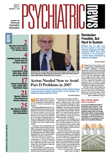Although fear is known to arise from the amygdala—that almond-shaped labyrinth located in front of the hippocampus—the molecular mechanisms of fear production have remained elusive.
Then, a few months ago, Gleb Shumyatsky, Ph.D., an assistant professor of genetics at Rutgers University; Nobel Prize–winning psychiatrist Eric Kandel, M.D., of Columbia University, and colleagues reported that a protein called stathmin, made in the amygdala, appears to be crucial for both the expression of innate fear and the formation of memory for learned fear (Psychiatric News, February 3).
Now more insights into the molecular mechanics of fear production appear to have been obtained by Shumyatsky, Kandel, and their group, and the metal zinc seems to be a crucial player. Results were published in the September 27 online early edition of the Proceedings of the National Academy of Sciences.
First the scientists found that zinc is plentiful in sections of the rat amygdala as well as in the rat auditory cortex, which sends auditory information to the amygdala during fear learning. Then they discovered that those nerves in the rat amygdala that use the neurotransmitter glutamate release zinc as well as glutamate when communicating with each other, and that release boosts electrical transmission between the nerves.
Thus zinc may well contribute to the learning of fear, the researchers concluded. Or as the lead researcher, Vadim Bolshakov, Ph.D., director of the Cellular Neurobiology Laboratory at McLean Hospital, put it in an accompanying press release: “Our results provide the first direct evidence that zinc released during the communication between neurons has an impact on neurotransmission in the amygdala, thus potentially contributing to fear learning.”
The findings may also lead to a new classification of anxiety disorders, Shumyatsky told Psychiatric News. “Our new study, along with our earlier work... demonstrates that the neuroanatomic circuits of fear and fear behaviors have their own molecular substrates. This, in turn, suggests that anxiety disorders are not of one common molecular origin, but instead have their specific molecular signatures..., and perhaps in the future will allow for a new type of classification of anxiety states according not only to their behavioral phenotypes, but also with regard to their anatomic and molecular characteristics.”
And the results might even lead to new antianxiety drugs, Shumyatsky speculated. “In our study, a gene encoding [the zinc transporter, which is a specific marker for zinc-containing nerves, was] expressed in the cortico-amygdala pathway, but not in the thalamo-amygdala pathway. These two parallel neural pathways are important in relaying fearful stimulus information... to the amygdala. Which of these two pathways is more important, or whether they are equally important, for fear behavior is not clear yet. However, their differences in zinc requirement suggest [that we might be able to design drugs] to target one type of fear processing versus another.”
The study was funded by the National Institutes of Health, the Esther A. and Joseph Klingenstein Fund, the National Alliance for Research on Schizophrenia and Depression, the New Jersey Governor's council on Autism, and the Charles and Johanna Busch Memorial Fund.
An abstract of “Synaptically Released Zinc Gates Long-Term Potentiation in Fear Conditioning Pathways” is posted at<www.pnas.org/cgi/content/abstract/0607131103v1>.▪
